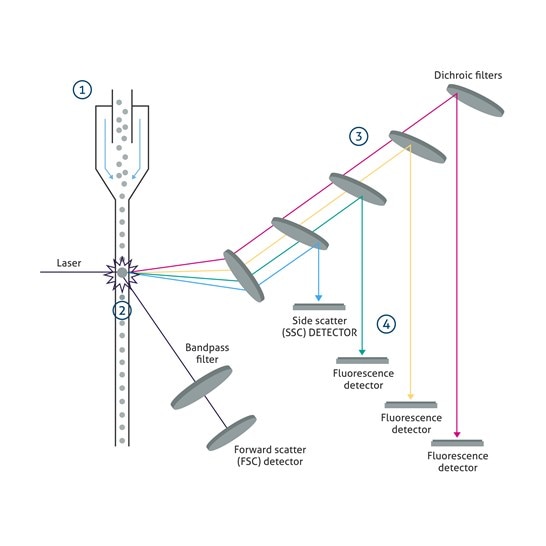Introduction to flow cytometry
リンク
- Introduction to flow cytometry
- Flow Cytometry Applications
- Flow Cytometry Fluorophores and Dyes
- Flow Cytometry Multicolor Panel Design
- Flow Cytometry Sample Preparation
- Protocol for studying extracellular and intracellular proteins
- Experimental protocol to study cell viability and apoptosis
- Popular antibodies for flow cytometry
Overview
Flow cytometry is a technique that enables the measurement of properties of individual particles (cells) in a heterologous population. This allows researchers to phenotype each cell based on these properties and in some cases also to sort cells into different subpopulations for further evaluation in specialized flow cytometry called fluorescence-activated cell sorting (FACS). In a flow cytometer, cells in suspension are forced into ‘single file’ to then pass through a laser, which enables the measurement of particle size and granularity. Further phenotyping occurs through using fluorescent conjugated antibodies that bind to target proteins on the cell surface or intracellularly, enabling the measurement of fluorescence intensity as another parameter.
How does flow cytometry work?
1. First, a cell suspension solution flows through the chamber where it is then separated into a stream of single cells by the fluidics system.
2. The solution then passes through a laser beam or a set of lasers (Figure 1 – flow cytometry overview).
3. A set of lenses, filters, and dichroic mirrors are used to collect and separate the light.
4. The light is collected at a 90-degree angle (side scatter – SSC) and directly opposite the cell flow (forward scatter – FSC).
5. The light is detected using photodiodes or photomultiplier tubes (PMTs).
Besides these inherent physical properties, fluorescence from markers can be assayed in a similar manner. Some flow cytometers can also sort cells based on the user gating conditions of these properties. This type of flow cytometry is often referred to as fluorescence-activated cell sorting (FACS).
Figure 1 - Flow Cytometry overview

Flow cytometry applications
- Analysis of plasma membrane receptor expression
- Analysis of cell viability, apoptosis, and necrosis
- Cell phenotyping
- Analysis of cell cycle
- Cell sorting
- Analysis of intracellular protein expression
- Biomarker detection
- Cell counting

